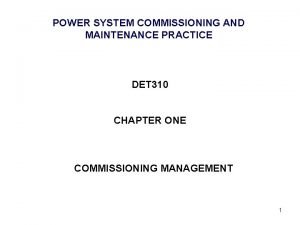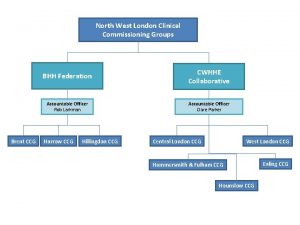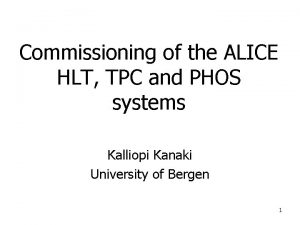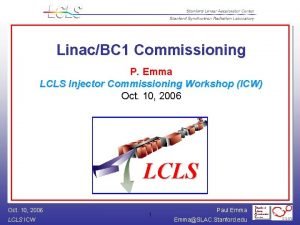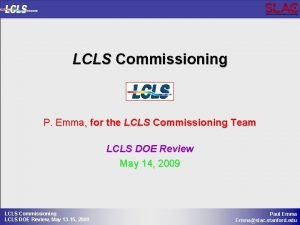Social Care Commissioning Mr David Petticrew Social Care























- Slides: 23

Social Care Commissioning Mr David Petticrew Social Care Commissioning Lead Northern Ireland Health and Social Care Board

Some Principles • Strategic regional overview • Longer term considered approach to the needs of the population • Information • Continuous cycle of review and improvement • Local variations • Market analysis and developing a provider base • Pilot projects before regional roll-out • Outcomes

A Formal Process • Joint HSCB and PHA ‘Annual Commissioning Plan’ • A response to Minister’s ‘Commissioning Plan Direction’ and targets • Translation of Minister’s Regional Priorities into Performance Areas • Trust response via Trust Delivery Plans

Commissioning Drivers • • • Legislative and policy context Regional Strategies – Dementia, Disability Demographics Inspections Public Interest Stakeholders

Drivers Ongoing Process: 3 and 5 year strategies Procurement (efficiency, quality, VFM) New learning Iterative process – speed of change and forward planning • Financial Context • •

Issue of Scale • HSC Residential, Nursing and Care home expenditure is circa £ 500 m pa • Predictive and responsive process • 25, 000 people receive domiciliary care • 13, 000 HSC care home residents • 465 homes with 16, 000 registered places

Regional Review of Domiciliary Care ‘A Managed Change An Agenda for Creating a Sustainable Basis for Domiciliary Care in Northern Ireland’

Focus • Domiciliary Care = ‘Home Help’? • ‘The range of services put in place to support an individual in their own home. Services may involve routine household tasks within or outside the home, personal care of the client and other domestic services necessary to maintain an individual in an acceptable level of health, hygiene, dignity, safety and ease in their home’ DHSSPSNI • Project May 2014 – November 2015 • Review of Trust and Independent sector provision • Excluded ‘private arrangements’ and family /informal carers

£ 206, 000 p. a. 250, 000 hrs p. w. 25, 000 Clients+ Complexity ++

Aims • Identify a more coordinated regional model for the development and procurement of domiciliary care • Analyse & compare existing Trust arrangements for delivering domiciliary care and identify best practice • Examine service interfaces with domiciliary care • Consult with stakeholders with regard to experience of domiciliary care services • Undertake an analysis of the market • Improve information relating to domiciliary care

Context • Information - Community Indicators Project • Market - Evidence of increasing pressures • Stakeholders - Trade Unions, Independent Sector, COPNI, Age NI, Patient Client Council, Age Sector Platform, Users/Carers • Interfaces - Reablement, Self Directed Support, Direct Payments, Telecare • Trust arrangements - Procurement, Rates

What People Told us • Broad consensus of views across a range of stakeholders – users, carers, providers, Trade Unions • Highly valued service • Plays a vital role in effective delivery of community care services (including impact on hospital services, carers etc) • Significant challenges (1) future procurement of the service (2) availability and development of the workforce (staff retention)

A highly valued service • Users and carers tell us the service impacts positively on the quality of their lives • Supports carers to keep their loved ones at home • Patient Client Council research found that 80% + of respondents rated the quality of care as “good” or “very good” • Through the PHA and HSCB jointly commissioned ‘ 10, 000 Voices’ initiative 1330 client stories were captured in relation to domiciliary care and 78% of respondents reported a positive experience of the service and 82% stated that domiciliary support in their own home had impacted positively on their lives • Trust feedback highlighted the compassionate care and help received

User Views - Overview • Users would like to see better communication and information between carers • More continuity of staff • Improved timing of calls and allocation of time • Ensuring the privacy and dignity of users is respected by staff • Ensuring staff are adequately trained to care for people with dementia • Maximising opportunities for client choice

The challenges to us from users/carers • A service ‘fit for the future’ • Addressing workforce related issues will be key to sustainability – current recruitment/retention • Partnership working – Independent Sector and Trusts • A model for the future that promotes independence and choice

Current Trust Arrangements • Good degree of similarity in underlying • management and organisation of the service User/ Carer satisfaction/ quality • Limited Inter-Trust liaison • Limited evidence of a ‘best practice’ approach • Individualised procurement/ rates • Workforce – recruitment, retention & training

Differences/Anomalies • Number of Providers • • • NHSCT -17 BHSCT- 23 SHSCT – 23 SEHSCT- 36 WHSCT– 12 • Sector Split (S v IS) • • • NHSCT 50: 50 BHSCT 25: 75 SHSCT 40: 60 SEHSCT 15: 85 WHSCT 35: 65

Pressures • • • Tendering exercises Workforce ‘National Living Wage’ Rates paid/ variations Squeeze on smaller providers (procurement ‘Lots’)

Procurement as a future service model driver • • Reduction in the number of providers Testing the market price for care Market share Provides a basis for moving from ‘time and task’ to an ‘outcomes’ based approach

Review Recommendations • Structure – A ‘Task Force’ approach to future Domiciliary/Community Care development • Funding – Coordinated approach to funding domiciliary care services to address cost pressures • Procurement – Management of tendering processes to co-ordinate and monitor change • Financial Modelling – Assessment of the impact of the living wage and the hourly cost of care provided by the statutory/independent sectors • Workforce – Consistent, Trained, Valued, Rewarded

• Service Model – No ‘perfect’ model identified • Information - Develop improved domiciliary care information • Finance – Make the case for investment in domiciliary care • Communication – all stakeholders

Future of Commissioning: • Change • Closure of the Board in March 2017 • Trusts will take responsibility for planning and meeting the future needs of their populations • DHSSPS adopt a more proactive role with Trusts ie performance management • DHSSPS will assume budgetary control

Opportunity • New model for HSC – shift away from hospital to community based care • Shift from statutory to private sector provision? • Out-workings of DHSSPS ‘Who Cares’ consultation? • Risk and opportunity
 Commissioning cycle
Commissioning cycle Aecp guidelines 2022
Aecp guidelines 2022 Steps
Steps Ecs commissioning
Ecs commissioning Heat pump balance point
Heat pump balance point Timeline jwst
Timeline jwst Hmsweb.hms
Hmsweb.hms Commissioning cycle
Commissioning cycle Value based commissioning
Value based commissioning Vacuum systems commissioning
Vacuum systems commissioning Power system commissioning
Power system commissioning Nihr ccf
Nihr ccf Dominik sikora
Dominik sikora North west london clinical commissioning group
North west london clinical commissioning group Commissioning
Commissioning Aabc commissioning group
Aabc commissioning group Lidl abb
Lidl abb Integrated commissioning and progress system
Integrated commissioning and progress system Croydon clinical commissioning group
Croydon clinical commissioning group Ecs commissioning
Ecs commissioning Primary care secondary care tertiary care
Primary care secondary care tertiary care Health and social care unit 2
Health and social care unit 2 Social thinking and social influence in psychology
Social thinking and social influence in psychology Social thinking social influence social relations
Social thinking social influence social relations










